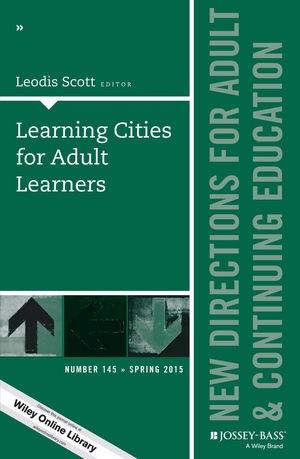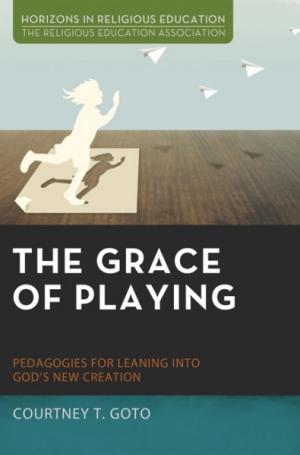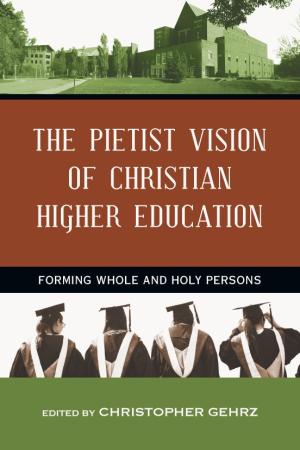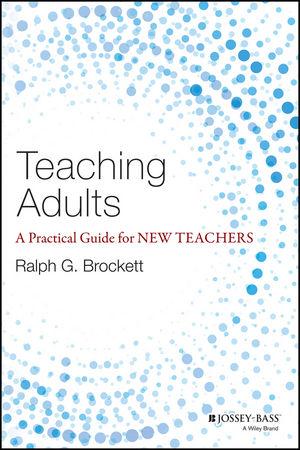Resources by Brant M. Himes

In Learning Cities for Adult Learners, Leodis Scott compiles seven articles that explore how cities are uniquely positioned to provide new directions for adult and continuing education. “Adult education needs more space,” Scott writes, and scholars and practitioners must take the lead in building larger spaces for all learners (1). The larger spaces are cities themselves – “learning cities” that take education beyond the traditional walls of schools, colleges, and workplaces in order to connect and grow in all life experiences. Scott suggests cities can take on the characteristics of learning, and in doing so, adults of every social class and educational level can experience a new quality of life. Scott is cofounder and research scholar at LearnLong Institute for Education and Learning Research, and lecturer in adult learning philosophy and practice at DePaul University–School for New Learning and Columbia University–Teachers College. Contributors to the volume come from a variety of universities, research centers, and programs that are committed to connecting the scholarship of adult learning with concrete practices that encourage a more widespread approach to learning. Most articles are co-authored, further demonstrating how collaboration and cross-disciplinary thinking is a natural hallmark of building the necessary infrastructure for learning cities. After an Editor’s Note by Scott, Connie Watson and Aimee Tiu Wu introduce key themes of lifelong learning and lifelong education in Chapter 1, as they explore the evolution and reconstruction of learning cities for sustainable actions. In Chapter 2, Hiram E. Fitzgerald and Renee Zientek write about the connections between learning cities, systems change, and community engagement scholarship in the context of a learning city/region. Lyle Yorks and Jody Barto investigate in Chapter 3 the interconnections between workplace, organizational, and societal learning, showing how 21st-century cities must function to promote learning for a larger society. In Chapter 4, Alysia Peich and Cynthia Needles Fletcher provide research and a case study for how public libraries and cooperative extension can work as community partners for lifelong learning and learning cities. In Chapter 5, Joanne Howard, Diane Howard, and Ebbin Dotson provide a connected history of health and education and demonstrate the necessity of including both health and education endeavors in any strategic planning of learning cities. Dan K. Hibbler and Leodis Scott write in Chapter 6 about the role of leisure in humanizing learning cities. Finally, Scott provides a summary in Chapter 7 of the main themes from the book and suggests a way forward: scholars and practitioners in the field of adult and continuing education can become facilitators of learning cities so that citizens have the power and ability to construct their own cities appropriate to their needs. This book is written for scholars and practitioners in adult learning and provides both a compelling vision and practical strategies for how citizens can work across fields and disciplines for the betterment of society. It will take leadership, vision, and talent to connect civic institutions in the formation of learning cities. One strategic type of institution not mentioned in the book is local religious communities. It seems that religious groups could be uniquely situated to both model and help facilitate the essential elements of a learning city. As scholars and practitioners continue to work towards this new direction for adult and continuing education, they will certainly do well to collaborate with as many different types of civic institutions as possible – for building a learning city is certainly worth the pursuit.

In The Grace of Playing, Courtney Goto offers a project in practical theology for Christian religious education that uses the notion of playing to better understand teaching and learning. Goto distinguishes her project from a formal practical theology of play, where play could be explored as a universal category of human existence. Instead, she works in the line of Paulo Freire’s search to move beyond a traditional schooling model of education towards learning that is more integrated, experiential, and creative. Specifically, Goto reflects critically on the notion of revelatory experiencing through the language and pedagogies of playing. Her focus is on playing as it relates to adult learning, and her investigation demonstrates – both conceptually and through case studies – how playing cultivates faith formation. Goto is an Assistant Professor of Religious Education at the Boston University School of Theology and a co-Director of the Center for Practical Theology. She writes as a third generation Japanese American United Methodist primarily for an audience of theorists, students, and practitioners who are liberal mainline Protestants. She invites Roman Catholic, Orthodox, and Charismatic Christians into the conversation as well, but notes that her advocacy of revelatory experiencing is to be understood in terms of the contextualized perspectives encountered in mainline Protestant churches. This is an important caveat. Theologically conservative readers will take issue with her concept of revelatory experiencing, whereby revelation happens in between persons as they relate to one another (as opposed to approaching Christian revelation as a totalizing meta-narrative). That Goto makes her theological liberalism so clear and defined, particularly in terms of her understanding of revelation, is a great service to readers. The Grace of Playing investigates playing from social scientific, theological, and historical perspectives and offers two case studies for application. After a preface and introduction, Chapter 2 explores psychoanalytical and psychological concepts of playing, relying particularly on D. W. Winnicott to articulate sociologically what occurs in revelatory experiencing. In Chapter 3, Goto turns to theology to build a theory and constructive proposal of play by appropriating insights from Jürgen Moltmann’s Theology of Play. Chapter 4 is a historical accounting of medieval practices of play, including the use of devotional dolls by fourteenth century nuns in the Rheinland, Germany and the practice of holy foolery by those in both Western and Eastern Church traditions. The final two chapters contain case studies of grace-filled play. The first describes the creation of a pretend garden at a Japanese American church for the purpose of congregational reconciliation, and the second briefly recounts a practice of playing with inmates in a juvenile detention center.To conclude, Goto demonstrates that the grace of playing leads a world in need towards God’s new creation. The Grace of Playing skillfully navigates insights from sociology, theology, and history to make a compelling case for the theological practice of play as a mediating, revelatory experience within Christian religious education. The book is readily accessible for students and practitioners, without neglecting the more technical needs of theorists. For the case studies, Goto deliberately refrains from providing much, if any, direct data; this effectively condenses the reading, but also leaves a sense of wanting to know more about how the grace of playing works itself into and through these unique settings. Overall, the book is a warm invitation for all to play in the fullness of God’s grace.

In The Pietist Vision of Christian Higher Education, Christopher Gehrz convenes an impressive array of scholars to offer fresh, cross-disciplinary reflections on how the Pietist mandate to form whole and holy persons can invigorate institutions of Christian higher education. Gehrz is professor of history and chair of the history department at Bethel University, and his ongoing work is focused on both tracing and promoting the Pietist impulse within Christianity. His co-authors represent a variety of disciplines, including English, theology, ethics, geography, psychology, nursing, anthropology, physics, philosophy, communication, sociology, and library sciences. The breadth of expertise serves to reinforce the underlying thesis of the book: the Pietistic traditions of seventeenth- and eighteenth-century Germany, nineteenth-century Sweden, and twentieth-century Minnesota can provide a “usable past” with which Christian colleges and universities in the twenty-first century can navigate the many challenges facing higher education. Faculty, staff, and administrators need not serve at institutions traditionally associated with the Pietist tradition to find resonance with the authors’ ideas and perspectives. While the chapters offer a healthy accounting of the influence of Pietism on Christian higher education, the calling to form “whole and holy persons” is broadly shared within the Christian tradition. To be sure, the chapters are written squarely from the Pietist perspective. However, all Christian educators can find avenues for reflection and practices for implementation within this book. The dedication to a holistic vision of student formation, mentoring, teaching, scholarship, and service is a shared and unifying value across the diversity of Christian institutions today – and even as this vision is articulated and pursued in different ways, the Pietist vision offers a unique and compelling framework for contemporary application. The Pietist Vision of Christian Higher Education is organized into four sections and includes an introduction and conclusion by Gehrz. Part one investigates the themes of teaching, scholarship, and community in the Pietist university. Part two explores how changed people change the world. Part three offers responses to the Pietist vision from the natural and health sciences. Part four then explores problems and proposals for putting the Pietist vision into practice. Each chapter is written by a different author, and this brings a refreshing collaborative tone to the entire volume. Even with seventeen different contributors, the book maintains a consistent tone and stays focused on Pietism’s unique influence on Christian higher education. The book is a testament to how the Bethel community deliberately embraces the “usable past” of their own Pietist tradition. Each author has a direct connection to the university, and this means that readers receive rare insights into the Pietist workings of an institution from many different perspectives, disciplines, and backgrounds. The downside to this institution-centric approach is that readers may be challenged by how to appropriate the uniquely-Bethel Pietist ethos to other institutional contexts. However, even though we now know what it means to foster Pietism’s usable past at Bethel, other universities can and should glean from Bethel’s insights as they explore the implications of their own usable pasts for innovation in the future.

Ralph Brockett has spent his career on the leading edge of adult learning theory and practice. He is widely published, a master in the classroom, and – having been inducted into the International Adult and Continuing Education Hall of Fame in 2005 (among other accolades) – has earned the respect and admiration of his peers. In Teaching Adults: A Practical Guide for New Teachers, Brockett takes the posture of a caring mentor to provide a succinct and accessible introduction to the dynamic field of adult learning. His style is conversational, his expertise evident, and he is clearly most interested in helping to equip you, the teacher, with very practical advice for teaching adults in a wide variety of formal and informal learning contexts. Teaching Adults is written for a variety of readers. Brockett suggests an audience that may include a professional tasked with offering a training session in her field, a layperson asked to teach an adult Sunday School class, and a scout leader needing to orient a cadre of adult volunteers. In addition, the book is applicable to those who may not primarily think of themselves as teachers, but who nevertheless spend a fair amount of time teaching – such as ministers, social workers, and health care professionals. Further, higher education professors and instructors will find this book valuable. As Brockett rightly points out, these educators are not always equipped to meet the unique needs of an ever-increasing population of adult learners. Finally, this book can benefit graduate students in the field of adult education, helping to further define and map the foundational concepts of adult learning. Teaching Adults is organized around a simple formula: effective teaching leads to successful learning! To illustrate this, Brockett weaves together (1) seven essential attributes of effective teachers and (2) four keys to effective teaching. To describe the qualities of effective teachers, Brockett continually reinforces seven characteristics: trust, empathy, authenticity, confidence, humility, enthusiasm, and respect. Attending to these essential qualities has a distinctive impact on the success of an adult learning event. Similarly, the four keys of effective teaching (know the content, know the adult learner, know about teaching, and know yourself) help to steward learning for maximum transfer and impact. Especially helpful in processing these concepts are the end-of-chapter “think about it” exercises and focused listings of additional resources. Teaching Adults is an accessible and valuable primer. New and seasoned teachers alike will find practical resources for honing their skills, whatever their educational context. As a basic, introductory text, this book is not peppered with citations and endnotes; however, its bibliography serves as an essential reading list for those new to the field of adult learning theory. I would venture to suggest one drawback: despite its focus on new teachers there is a noticeable lack of discussion of new and emerging learning modalities (such as online environments). The concepts from the book are certainly applicable to all forms of teaching and learning, but an explicit mention of how these could be worked out in the online environment would have reflected the educational learning experiences for many new teachers and learners. The book does contain a self-made remedy, however. The end-of-chapter reflection questions provide teachers from any background with the implicit wisdom needed for addressing the diverse and ever-changing landscape of teaching and learning.